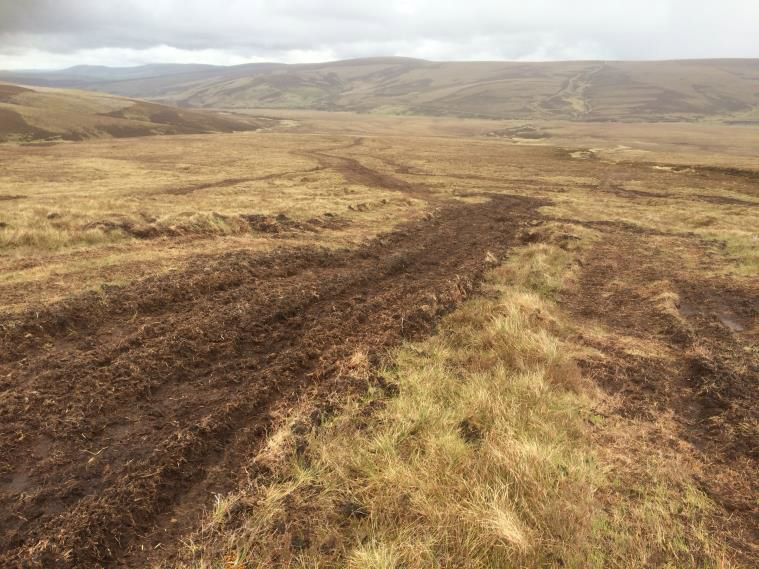
George Allan
There have been concerns that new tracks might have been constructed illegally under the blanket of lockdown. This doesn't appear to have happened to any great extent but some horrors may yet emerge. One such track, in Glen Beanie in the lower reaches of Glen Isla, was brought to LINK's attention; this is being investigated by Angus Council.
As part of a wide ranging review of various aspects of permitted development by the Scottish Government, a consultation was held on peatland restoration; NEMT responded to this. There is a drive at national level to restore damaged peatland and NEMT strongly supports this. It has significant landscape benefits as well as preventing the release of carbon dioxide. NEMT was concerned however, that unless a measure of statutory oversight of any temporary tracks is put in place, the ground affected by these will not be properly reinstated or, in some instances, the tracks will not be removed at all. Unrestricted permitted development would allow a loophole in the hard won, though still inadequate, controls on tracks which came into force in 2014, a loophole which unscrupulous landowners would no doubt take advantage of. NEMT was also keen to ensure that any regime for peatland restoration should ensure that work undertaken is of high quality. Peat restoration is undertaken under two financial mechanisms. Firstly, landowners can receive grants from the Scottish Government from Peatland Action, as subsidiary of NatureScot. This system provides a significant level of oversight. The second mechanism is potentially more problematic. Commercial interests wanting to offset their carbon use can fund peatland restoration and they can undertake this subject to standards under a voluntary code of practice (The Peatland Code). In its response to the consultation, NEMT expressed concern that allowing unrestricted Permitted Development Rights for work undertaken under the Code would not provide adequate public accountability, particularly in relation to quality of the work.
 |
| Peat erosion by vehicles, by the Steplar Road © C Lacy |
Following the consultation, the Government decided that peatland
restoration, while enjoying Permitted Development status, will, none the
less, be subject to Prior Notification which will give planning
authorities a level of control. NEMT welcomes this. Tracks for restoration
work will be considered as part of the forthcoming review of the
legislative control of hill tracks (see next paragraph).
At the time of writing, we are still awaiting the consultation on permitted development and hill tracks. NEMT will be working with LINK to put the case that the current Prior Notification system is inadequate and stronger legislative controls are necessary to protect the landscape and avoid damage to peat and soils.
A while back, a LINK delegation which included a representative of NEMT, met with the Convenor and CEO of the Cairngorms National Park, along with other senior staff, to discuss all things hill tracks. LINK raised the growing concerns about the damage being caused by widespread and careless use of all terrain vehicles. Grant Moir, CEO of the Park, immediately referred the issue to the Park's Upland Advisory Group of which Dave Windle, NEMT's chair, is a member. The Group drafted a guidance document on ATV use for land managers which appears in this issue of Mountain Views, and which is also available at https://cairngorms.co.uk/working-together/land-management/support.
There has been interest in this from outside the Park which is good news. The guidance is broad brush and, of course, voluntary. It is hoped that it will be taken seriously and used in training estate staff. The proof of this pudding will be very much in the eating. If voluntary guidance is ineffective in reducing scarred landscapes and damaged peat, then the LINK Hill Tracks Group will need to consider what other steps can be taken.
Glen Clova estate, which owns the hotel, is developing a proposal for a major woodland creation project which will alter the landscape in the upper reaches of the glen. If this goes ahead, woods will cover the lower flanks of the hills to the north east of the road, stretching from south of the hotel to short of the Red Craigs. The draft plan also includes smaller areas of planting on the south west side of the river along with peat and habitat restoration. The proposals involve sections of broad leaf trees and native pines as well as conifers, a mix which is to be welcomed. Ramblers Scotland was consulted about access issues and one of their staff approached NEMT regarding whether this could cause problems for people visiting the various climbing grounds. NEMT made comments on this aspect for Ramblers Scotland to feed back; Ramblers has also advised Mountaineering Scotland. Interestingly the plans include the retention of the stretch of illegally constructed track above the hotel which the estate is obliged to completely removed. If the forestry plan goes ahead, this should no longer be a problem as it will become 'lost' in woodland.
Please let the webmaster know if there are problems with viewing these pages or with the links they contain.